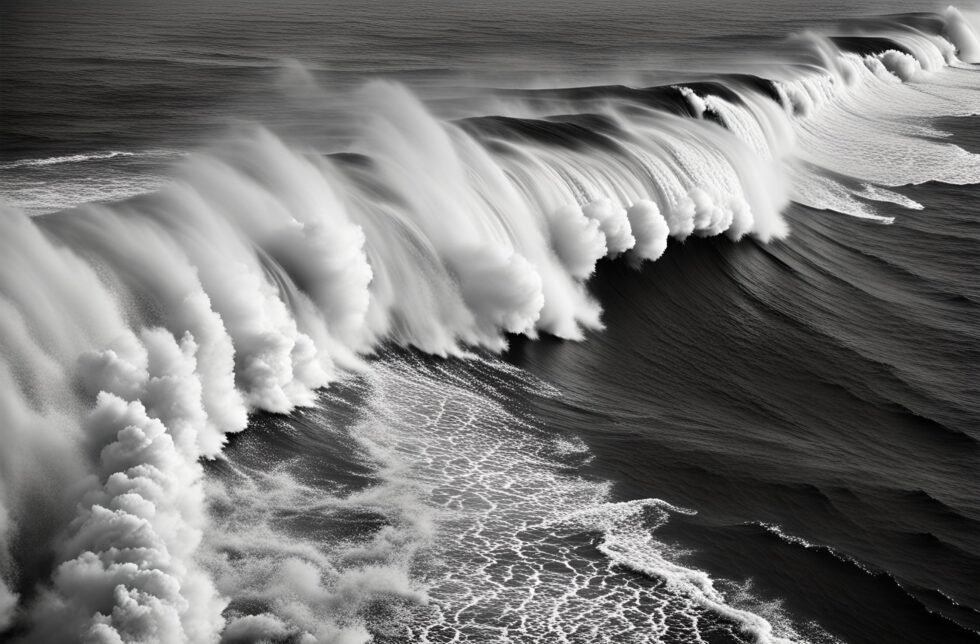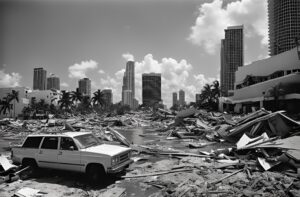
The morning of June 15th began like any other in the bustling coastal city of Miami. As the sun rose, casting a golden hue over the pristine beaches, the city’s inhabitants went about their daily routines, blissfully unaware of the cataclysmic event that would soon alter their lives forever.
The first sign of trouble came from the ocean itself. Fishermen and early morning surfers noticed an unusual stillness in the water, a foreboding calm that sent shivers down their spines. Birds, too, seemed to sense the impending doom, their cries growing frantic as they took to the skies in droves.
By mid-morning, local news stations were buzzing with reports of a massive underwater earthquake off the coast of the Caribbean. Seismologists warned of potential aftershocks, but it wasn’t until the National Oceanic and Atmospheric Administration (NOAA) issued a tsunami warning that the gravity of the situation began to sink in. Panic spread like wildfire as evacuation orders were broadcast, urging residents to seek higher ground immediately. Highways became clogged with vehicles, and the air was filled with the sounds of blaring horns and sirens as people scrambled to escape the approaching menace.

The tidal wave, a monstrous wall of water over 100 feet high, struck with a force that defied comprehension. It swallowed entire neighborhoods, obliterating everything in its path. Skyscrapers crumbled like sandcastles, and the once-vibrant streets of Miami were transformed into a chaotic, watery wasteland. The wave continued its relentless march inland, reaching as far as Orlando and leaving a trail of devastation in its wake.
The immediate aftermath was a scene of unparalleled destruction. Survivors clung to debris, their faces etched with shock and disbelief. Emergency services were overwhelmed, struggling to navigate the flooded streets and reach those in need. The death toll was staggering, and the number of missing persons grew by the hour.
In the days that followed, the true scale of the disaster became apparent. Entire communities had been wiped off the map, and the infrastructure of the affected areas was in ruins. Power outages were widespread, and clean water and food supplies dwindled rapidly. The federal government declared a state of emergency, and aid began to pour in from around the world. Volunteers and rescue teams worked tirelessly, but the sheer magnitude of the catastrophe made recovery seem like an insurmountable task.
As the waters receded, the focus shifted from rescue to rebuilding. The survivors, many of whom had lost everything, faced the daunting challenge of starting over. Makeshift shelters sprang up, and relief organizations provided essential supplies and medical care. The spirit of resilience and solidarity was palpable, as people came together to support one another in the face of unimaginable adversity.
Amid the ruins, stories of heroism and compassion emerged. Neighbors risked their lives to save strangers, and communities banded together to salvage what little they could. The disaster had brought out the best in humanity, and the bonds forged in the aftermath would endure long after the waters had receded.
In the years that followed, the East Coast of Florida underwent a profound transformation. The rebuilding efforts were monumental, and the scars of the tidal wave remained visible in the altered landscape. New regulations and building codes were implemented to ensure that future structures could withstand such a calamity. Coastal defenses were strengthened, and early warning systems were enhanced to provide more time for evacuation in the event of another tsunami.
The disaster also sparked a global conversation about climate change and the increasing frequency of extreme weather events. Scientists and policymakers worked together to develop strategies for mitigating the impact of such disasters, and communities around the world took steps to become more resilient in the face of nature’s fury.
For the survivors, the memory of that fateful day would never fade. It had reshaped their lives in ways they could never have imagined, but it had also brought them closer together. The tidal wave had tested the limits of human endurance and compassion, and in the end, it was the indomitable spirit of the people that triumphed. The East Coast of Florida, once a symbol of leisure and luxury, had become a testament to the strength and resilience of the human spirit. The tidal wave had left a mark that would never be erased, but it had also revealed the true depth of humanity’s capacity for hope, courage, and unity.




